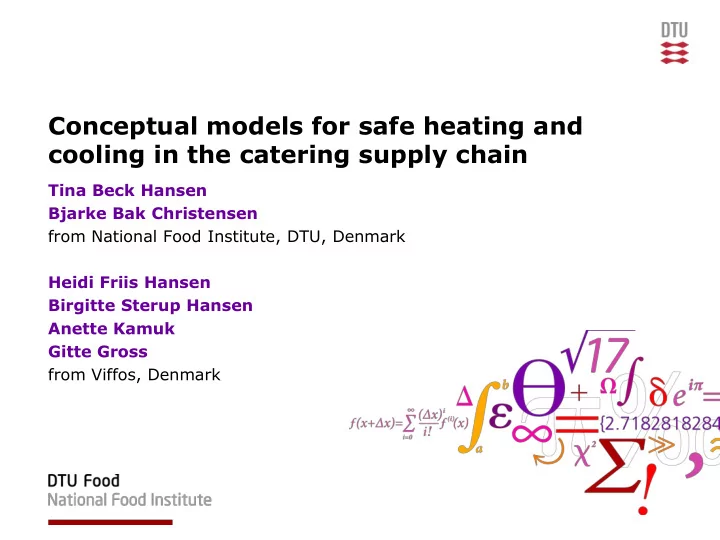

Conceptual models for safe heating and cooling in the catering supply chain Tina Beck Hansen Bjarke Bak Christensen from National Food Institute, DTU, Denmark Heidi Friis Hansen Birgitte Sterup Hansen Anette Kamuk Gitte Gross from Viffos, Denmark
Goals of the models • Establishment of safe heating • Documentation of safe heating and cooling 2 DTU Food, Technical University of Denmark Safe heating and cooling in catering 28/09/2010
Model assumptions Log-linear inactivation kinetics: D- and z-values Pasteurization value: Equivalent treatments: z = 10 (( Tref – Tnew )/z) PV Tref Time to obtain a lethal effect of a PV Tnew z heat treatment at a given temperature and z-value. Tnew = New temperature Tref = Reference temperature Lethal effect of heat treatment: z = z-value end z Log-reductions: (( T Tref ) / z ) PV 10 t Tref start Log reduction = PV T z / D T T = Temperature in the food T ref = Reference temperature T = Temperature z = z-value PV T z = lethal effect at temp. T t = heat treatment time D T = D-value at temperature T 3 DTU Food, Technical University of Denmark Safe heating and cooling in catering 28/09/2010
Safe heating and cooling – performance criteria Heat gently for immediate use Keep chilled for Cool down for longer time use later use L. monocytogenes – 4D Prevalence Source: Hansen & Knøchel 2001, IJFM 63, pp. 135 Numbers Heat tolerance Cl. botulinum (psychrotrophic) – 6D Growth potential Source: Peck 1997, Trends FST 8, pp. 186 Severity Cl. perfringens – 1 log 10 increase Susceptibility Source: Andersen et al. 2004, JFP 67, pp. 83 4 DTU Food, Technical University of Denmark Safe heating and cooling in catering 28/09/2010
Heat tolerance – influence of product type Listeria monocytogenes 2.0 1.5 1.0 z = 6.5 o C Log D-value 0.5 0.0 Salmon z = 7.0 o C Cod -0.5 Milk -1.0 z = 5.5 o C z = 6.0 o C Beef -1.5 Lineær -2.0 50 55 60 65 70 75 Heating temperature (°C) Source: Doyle et al. 2001, JFP 64, pp. 410 5 DTU Food, Technical University of Denmark Safe heating and cooling in catering 28/09/2010
Heat tolerance – influence of salt content Source: Jørgensen et al. 1995, JAB 79, pp.274 15 Heat tolerance – 4D 10 (min) 4D 5 0 0.5 3 6 9 20 % salt in the water phase % salt i vandfasen 6 DTU Food, Technical University of Denmark Safe heating and cooling in catering 28/09/2010
Heat tolerance – influence of heat injury Heat Degree of heat Days until Days until treatment injury growth at 3 ° C growth at 10 ° C pH 5.6 pH 6.2 pH 5.6 pH 6.2 Start population Injured 0% - - - - Not-injured 100% >30 <10 <10 <10 1D – 2D Injured 95-99% >30 >30 10-20 <10 Not-injured 1-5% >30 >30 10-20 10-20 3D – 4D Injured >99.9% >30 >30 >30 >30 Not-injured <0.1% >30 >30 >30 >30 Source: Hansen & Knøchel 2001, IJFM 63, pp. 135 7 DTU Food, Technical University of Denmark Safe heating and cooling in catering 28/09/2010
Safe heating – process criteria Questions to answer ANSWER Product type? (fish, meat, vegetables, other) FISH Is the product intended for consumption immediately after YES heating? (YES, NO) Is the product intended for keeping at one of the following conditions Not relevant in this - 3 o C? example - 5 o C for max. 10 days? - 5-10 o C for max. 5 days? (YES, NO) Does the product contain >3% salt-in-water? (YES, NO) NO Wanted end-temperature in the product? ( 60 o C) 65 o C A safe heating process should have a PV corresponding to 4.8 min at 65 o C in the coldest spot 8 DTU Food, Technical University of Denmark Safe heating and cooling in catering 28/09/2010
Documentation – the coldest spot 65 PV 65 (fish) = 5.3 min Temperature in coldest spot (°C) 60 55 Factors affecting PV 50 45 40 • Unequal product size 35 PV 65 (fish) = 3.1 min (Hansen et al. 1995, IJFST 30, pp. 365) 30 • Start-temperature 25 (Knøchel et al. 1997, ZLUF 205, pp. 370) 20 • Location in oven 15 (Hansen 1996, PhD Afh., p. 47) 10 • HTST vs. LTLT 5 (Hansen 1996, PhD Afh., p. 47) Filet of cod in oven 0 -5 0 10 20 30 40 50 60 70 Heating time, min at 80°C 9 DTU Food, Technical University of Denmark Safe heating and cooling in catering 28/09/2010
Safe cooling – process criteria BACKGROUND • That temperature profiles during cooling follow exponentially decreasing relationships when the cooling conditions are constant Source: Blankenship et al. 1988, AEM 54, pp. 1104 • That Clostridium perfringens should not reach a hazardous level A safe cooling process should Source: Andersen et al. 2004, JFP 67, pp. 83 pass the interval from 50 to 15 ° C in max. 3 h in the hottest spot 10 DTU Food, Technical University of Denmark Safe heating and cooling in catering 28/09/2010
Simulation of cooling 100 90 Rice pudding Product temperature (°C) 80 Start-temperature 87 o C 70 Cooling time 5.5 timer 60 End-temperature 2 o C 50 40 30 20 10 1 h 48 min 0 0 1 2 3 4 5 6 Cooling in water (hours) 11 DTU Food, Technical University of Denmark Safe heating and cooling in catering 28/09/2010
Conclusions • The present work served as an example of using the risk management concept, performance criterion, for the definition of safe heating and cooling in the catering industry • It was demonstrated how these performance criteria could be translated into more practical process criteria by the use of predictive models 12 DTU Food, Technical University of Denmark Safe heating and cooling in catering 28/09/2010
Recommend
More recommend